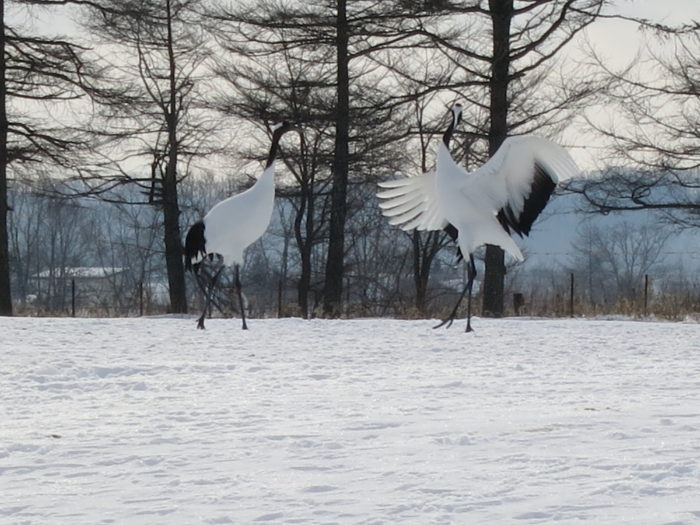Tancho cranes are lucky creatures. Once they proliferated all over Japan, but under the Tokugawa shogunate they were hunted to near extinction. You can see why. They are large and slow and spend a lot of time standing on one leg in marshes – which deters foxes, but presents a tempting target to any half-starved samurai with a bow and arrow.
Their saving grace is they are extremely photogenic. In the early decades of the twentieth century somebody had the bright idea of feeding the dozen birds that remained in the sparsely populated marshland of eastern Hokkaido. Now they number in the thousands and bird-watchers from all over the world come to observe them, particularly in the early months of the year when they emerge from the half-frozen marshes to engage in a waltz-like mating dance.
Tancho cranes have successfully marketed themselves as Japanese icons to rank with Mount Fuji, sushi and Hello Kitty. But their existence remains artificial. If the bureaucrats of the Environmental Agency withdrew funding, there would be nobody to feed the birds in the winter months and they would face the harsh Darwinian reality of life in the wild.
That’s not going to happen, since the local tourism industry depends on them. Every morning a human being appears and, much to the squawking delight of the expectant tancho, provides an ample breakfast of sweet corn.
Unsurprisingly, welfare dependency has had a corrosive effect on incentives. Locals say that some birds are refusing to go back to the marshlands in the spring. All of them have lost their innate fear of larger creatures. If a Hokkaido brown bear came lumbering out of the woods, they would probably rush towards it in the hope of scoring some free corn.
A few miles further into the snow-bound wasteland you can find the deserted habitation of a man who chose the opposite path in life from the tancho crane. Koji Hasegawa (1898-1975) was a kind of Japanese Thoreau, though more authentic than Thoreau ever was.
An intellectual who studied literature at Hitotsubashi University, he changed his worldview when his graduation thesis on William Morris got burnt to a crisp in the Great Kanto Earthquake of 1923.
At the age of twenty five, he moved to the wilds of Hokkaido in order to live a life of complete self-sufficiency. He built his house with his own hands and supported his wife and children from the produce of their small farm. The inhabitants of Tsurui Mura, the nearest village, considered him a weirdo and had little to do with him.

Even today the Hasegawa farm is isolated and barely accessible in the winter months – enclosed on three sides by marshland, with no electricity, no phone-lines, no path capable of accommodating a vehicle. In Hasegawa’s time the most efficient method of transportation was by the river that flows past his farm and on to Tsurui Mura and ultimately the port of Kushiro.
These tenuous links enabled Hasegawa to develop an extraordinary range of intellectual interests. He was a poet himself, who contributed to haiku magazines and sometimes wrote in German. His library contains hundreds of volumes, including learned works on history, geography and religion as well as classic works of literature in Japanese, English and French. He was also interested in modern jazz and films and had a wide range of correspondents in Japan and overseas.
Not many people walk the talk. Hasegawa did, sticking to his principles until illness finally claimed him. Now he’s almost forgotten and his farm has become a sad ruin. Meanwhile the tancho are everywhere – to the extent people complain about them flying into telephone wires. But the humans have come to depend on the tancho, which have come to depend on the humans.
In contrast, Hasegawa opted for total independence – from government, society and the prevailing zeitgeist.
He should be a Japanese icon too.
